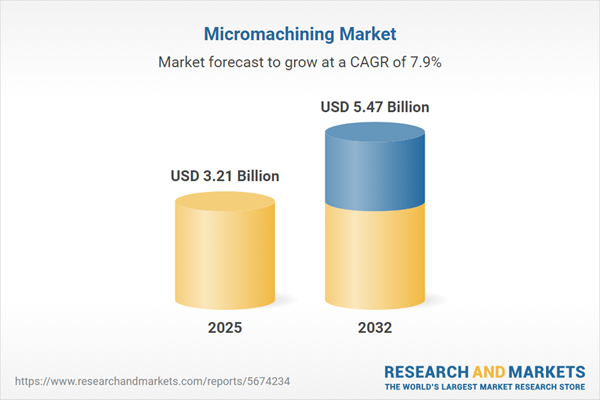Speak directly to the analyst to clarify any post sales queries you may have.
Micromachining is at the heart of advanced precision manufacturing, enabling the production of highly complex, miniaturized components for critical industries worldwide. As technology and operational landscapes evolve, market leaders must understand the factors shaping growth and competitive positioning within the micromachining sector.
Market Snapshot: Micromachining Market Size and Growth
The micromachining market grew from USD 2.97 billion in 2024 to USD 3.21 billion in 2025. It is expected to continue expanding at a CAGR of 7.92%, reaching USD 5.47 billion by 2032. This sustained growth is fuelled by advancements in automation, digital technologies, material science, and strong demand from sectors such as aerospace, healthcare, automotive, and electronics.
Scope & Segmentation of the Micromachining Market
This report delivers an in-depth analysis of the micromachining market, breaking down major opportunities, technology trends, and strategic segmentation:
- Process Types: Chemical micromachining, electrical discharge micromachining, laser micromachining, mechanical micromachining, ultrasonic micromachining.
- Material Types: Ceramics, composites, metals, polymers.
- Product Types: Consumables, equipment, services.
- End Use Industries: Aerospace and defense, automotive, electronics, medical devices.
- Applications: Cutting, trimming, drilling, patterning, surface texturing.
- Regions Addressed: Americas (United States, Canada, Mexico, Brazil, Argentina, Chile, Colombia, Peru), Europe, Middle East, Africa (United Kingdom, Germany, France, Russia, Italy, Spain, Netherlands, Sweden, Poland, Switzerland, UAE, Saudi Arabia, Qatar, Turkey, Israel, South Africa, Nigeria, Egypt, Kenya), Asia-Pacific (China, India, Japan, Australia, South Korea, Indonesia, Thailand, Malaysia, Singapore, Taiwan).
- Key Companies Profiled: TRUMPF GmbH + Co. KG, Coherent, Inc., IPG Photonics Corporation, GF Machining Solutions AG, Makino Milling Machine Co., Ltd., Sodick Co., Ltd., Mitsubishi Electric Corporation, Amada Co., Ltd., Jenoptik AG, Renishaw plc.
Key Takeaways for Senior Decision-Makers
- Micromachining processes have evolved to integrate advanced robotics, machine vision, and closed-loop feedback, elevating accuracy and productivity for manufacturers.
- Digital twins and AI-driven analytics are actively being used for toolpath optimization, cycle time reduction, and predictive maintenance, streamlining operations in high-precision environments.
- The adoption of hybrid manufacturing—combining additive and subtractive techniques—enables the fabrication of intricate internal features and surface finishes not previously possible.
- Heightened environmental focus has driven the transition to water-based coolants, biodegradable lubricants, and ultrafast lasers, reducing operational footprint and minimizing thermal stress.
- Regional activity is concentrated around major manufacturing hubs in North America, Western Europe, and Asia-Pacific, where policy incentives and strong research ecosystems stimulate continuous innovation and capacity expansion.
Tariff Impact: Navigating U.S. Policy and Supply Chain Realignment
Recent United States tariff policies have introduced extra duties on select micromachining equipment and consumables, impacting supply chain costs and procurement decisions. Manufacturers are adjusting by seeking domestic or tariff-exempt sources, renegotiating supplier contracts, and reshoring operations to maintain cost-competitiveness and operational agility in a changing policy environment.
Methodology & Data Sources
This report employs a robust, multi-source methodology, combining in-depth interviews with senior executives, R&D leaders, and application engineers, alongside reviews of peer-reviewed journals, technical standards, white papers, and regulatory filings. All data and insights have been meticulously cross-verified and peer-reviewed to ensure accuracy and impartiality.
Why This Report Matters
- Gain actionable insights to inform technology investments, process improvements, and strategic planning in the micromachining market.
- Strengthen supply chain and risk management strategies through regional, policy, and competitive analysis tailored to your sector.
- Identify niche opportunities and innovation priorities that align with emerging industry requirements and operational excellence goals.
Conclusion
Micromachining is a critical enabler of precision engineering in globally competitive industries. This report provides clear strategic guidance for leveraging the latest technologies, navigating market shifts, and achieving sustainable growth through informed decision-making.
Additional Product Information:
- Purchase of this report includes 1 year online access with quarterly updates.
- This report can be updated on request. Please contact our Customer Experience team using the Ask a Question widget on our website.
Table of Contents
3. Executive Summary
4. Market Overview
7. Cumulative Impact of Artificial Intelligence 2025
List of Figures
Samples

LOADING...
Companies Mentioned
The key companies profiled in this Micromachining market report include:- TRUMPF GmbH + Co. KG
- Coherent, Inc.
- IPG Photonics Corporation
- GF Machining Solutions AG
- Makino Milling Machine Co., Ltd.
- Sodick Co., Ltd.
- Mitsubishi Electric Corporation
- Amada Co., Ltd.
- Jenoptik AG
- Renishaw plc
Table Information
| Report Attribute | Details |
|---|---|
| No. of Pages | 198 |
| Published | October 2025 |
| Forecast Period | 2025 - 2032 |
| Estimated Market Value ( USD | $ 3.21 Billion |
| Forecasted Market Value ( USD | $ 5.47 Billion |
| Compound Annual Growth Rate | 7.9% |
| Regions Covered | Global |
| No. of Companies Mentioned | 11 |









